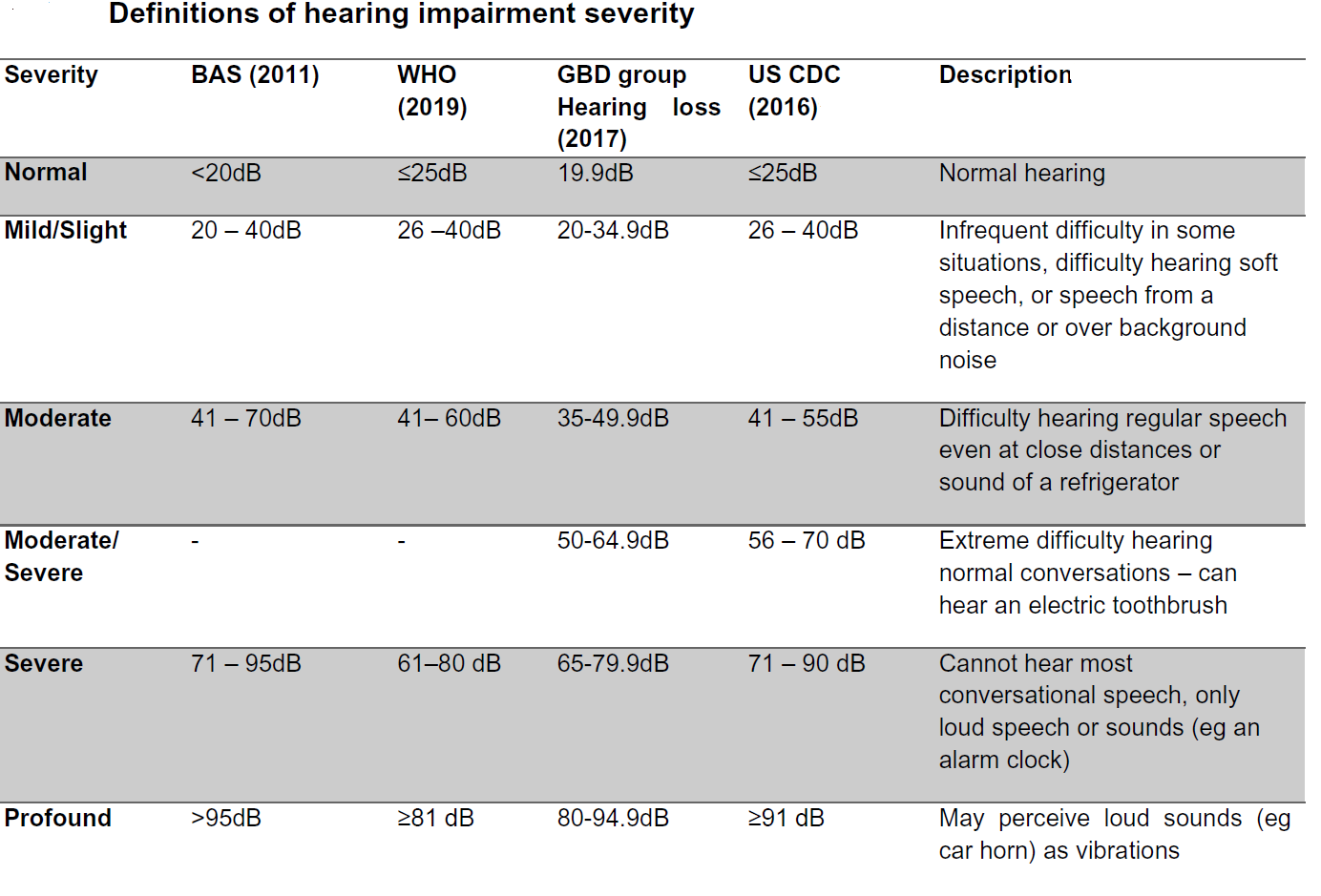Definition of hearing loss in adults
Definition of hearing loss
There is no universally agreed definition for hearing loss and reference criteria vary in terms of the thresholds of intensity (loudness), measured in decibels (dB) and tone (speed of sound wave vibrations), measured in Hertz (Hz); and whether one or both ears are affected.
- a person with normal hearing perceives sounds at frequencies between 20 and 20,000 Hz and for language processing the most important range is between 400 and 5000 Hz (1)
- commonly used reference criteria include the Ventry and Weinstein criteria (2) (>40 dB hearing loss at either 1000 or 2000 Hz in one or both ears), the speech frequency pure-tone average (SFPTA) criteria (3), (>=25 dB average hearing loss at 500, 1000, and 2000 Hz in the better ear) and the high-frequency pure-tone average (HFPTA) criteria (>=25 dB average hearing loss at 1000, 2000, and 4000 Hz in the better ear) (4)
- more recent definitions of hearing impairment severity have been developed and Table shows the criteria used by the World Health Organisation (5), the Global Burden of Disease (GBD) Expert Group on Hearing Loss (6), the British Society of Audiology (BAS 2011) (7) and the US Centre for Disease Control (US CDC 2016) (8)

BAS -British Society of Audiology, GBD – Global Burden of Disease, US CDC – United States Centre for Disease Control, WHO – World Health Organisation
Davis et al (2007) (9) reported that the threshold of mild to moderate hearing loss where a hearing aid may be of benefit is >35db.
Reference:
- Yueh B, Shapiro N, Maclean CH & Shekelle PG. Screening and management of adult hearing loss in primary care: scientific review. Jama, 2003; 289, 1976-85
- Ventry IM, Weinstein BE. Identification of elderly people with hearing problems. ASHA. 1983;25(7):37–42
- Clark JG. Uses and abuses of hearing loss classification. ASHA. 1984;23:493–500.
- Goldstein D. Hearing impairment, hearing aids and audiology. ASHA. 1984;26:24–35
- Olusanya B, Davis A, Hoffman H. Hearing loss grades and the International classification of functioning, disability and health. Bull World Health Organ 2019;97:725–728 | doi: http://dx.doi.org/10.2471/BLT.19.230367 725
- Global Burden of Disease Study. Global, regional, and national incidence, prevalence, and years lived with disability for 328 diseases and injuries for
195 countries, 1990–2016: a systematic analysis for the Global Burden of Disease Study 2016, Lancet 2017; 390: 1211–59 - British Society of Audiology Recommended Procedure Pure-tone air conduction and bone conduction threshold audiometry with and without masking 2011 BSA http://www.thebsa.org.uk/wpcontent/uploads/2011/04/BSA_PTA_Dec_15_minor_ammendments.pdf Accessed July 14th 2020
- Centers for Disease Control and Prevention. National Health and Nutrition Examination Survey (NHANES) audiometry procedures manual. January 2016. https://wwwn.cdc.gov/nchs/data/nhanes/20152016/manuals/2016_Audiometry_Procedures_Manual.pdf Accessed July 14th 2020
- Davis A, Smith P, Ferguson M, Stephens D, Gianopoulos I. Acceptability, benefit and costs of early screening for hearing disability: a study of potential screening tests and models. Health Technol Assess 2007;11(42)
Create an account to add page annotations
Annotations allow you to add information to this page that would be handy to have on hand during a consultation. E.g. a website or number. This information will always show when you visit this page.